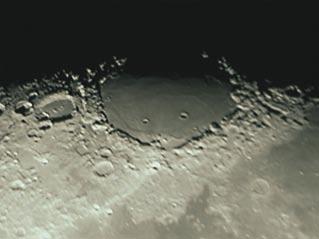Tammy Plotner and Jeff Barber, Universe Today

Check on the IOTA website when exactly the event takes place in which the moon hides the asteroid Vesta.
Tonight we will return to Mara Chrysium on the moon and look for some challenging signs. Let's start at the southern shore of the "sea" and identify the crater Shapeli trapped on the edge of the sea's surface. Two small gray ovals can be seen a little southeast of Shafley. The northern one between them is Primicus Crater, and the southern one is Apollonius Crater. South of Lohm you can see the gray smooth area of Sinus Successus.
If you look at the pale peninsula on the northern coast of Soxsus, you see the Amargino Crater and the planned landing area of two of the Lunar missions - 18 and 20.
As the moon sets look toward the Hercules group at high magnification and look for the 9th magnitude penetral nebula, NGC 6210. This small disk will not be easy to separate from its neighboring stars without magnification.
To locate NGC 6210, look for Beta and Gamma Hercules. Draw an imaginary line between them and extend it a similar distance towards the northwest. The nebula, which is about 6,500 light years away from us, is one of the most active planetary nebulae. The Hubble Space Telescope showed hot jets of gas
digging through an outer layer of cold gas.
* Volunteers are needed to translate the rest of the series in order to ensure its continuity. Please contact for details to the site editor
Project 365
UNIVERSE TODAY website
https://www.hayadan.org.il/BuildaGate4/general2/data_card.php?Cat=~~~490155182~~~261&SiteName=hayadan
